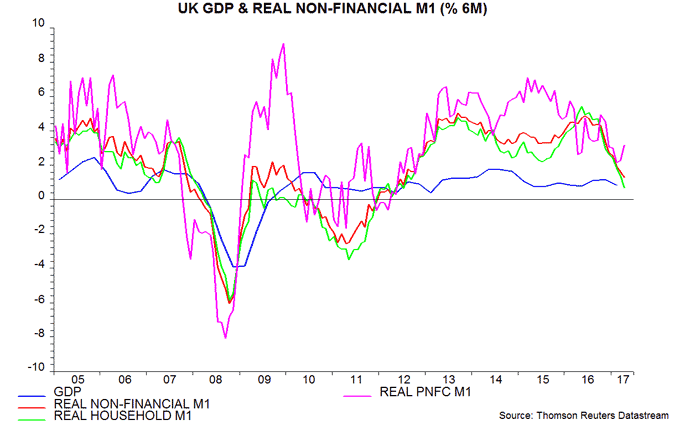The UK narrow and broad money measures tracked here posted respectable monthly rises in April but their six-month growth rates remain much lower than last autumn. With six-month consumer price inflation rising further in April, real-terms growth continued to subside, to its lowest since 2011-12. GDP growth will probably rebound in the second quarter but these trends suggest a significant slowdown during the second half. Household money growth has fallen by more than corporate growth, consistent with consumer-led weakness.
The narrow non-financial M1 aggregate rose by 0.7% in April but six-month growth edged down further to 3.2% – the lowest since 2014 and down from 5.2% in October 2016. The broader non-financial M4 measure increased by 0.5% in April, while six-month growth recovered slightly, though is also much lower than last autumn – see first chart.

Real money trends have been further squeezed by a sharp rise in the six-month rate of change of consumer prices (seasonally adjusted), which reached 1.9% in April, or 3.8% annualised.
Six-month growth rates of real non-financial M1 and non-financial M4 in April were, therefore, the weakest since 2012 and 2011 respectively – second chart.
The third chart shows real non-financial M1 growth broken down between households and private non-financial corporations (PNFCs). Household growth is weaker, consistent with a consumer-led economic slowdown. A recent uptick in PNFC growth is reassuring, suggesting that companies are still planning to expand investment and employment. (PNFC real narrow money has contracted before recessions historically.)

The focus here is on non-financial aggregates because financial sector money holdings contain little information about near-term prospects for spending on goods and services, and are often distorted by special factors. The Bank of England’s M4ex broad money measure rose by 7.3% in the year to April, outpacing a 5.4% increase in non-financial M4, reflecting strong growth in deposits held by insurance companies and pension funds, other fund managers and securities dealers. Part of this deposit rise may be connected with the implementation of liability-driven investment strategies by or for pension funds, with no economic implications. In addition, institutions may have switched out of Treasury bills and repos with the Debt Management Office (DMO) into bank deposits, i.e. M4ex overstates the growth of their total liquid assets. The stock of Treasury bills and “other central government debt” (mainly DMO repos) held by the private sector fell by £23 billion in the year to April.
The old M4 measure is even stronger than M4ex, rising by 8.2% in the year to April, reflecting a surge in deposits from “central clearing counterparties” – these increased by £56 billion, equivalent to 2.6% of M4, in the latest 12 months. Such deposits mostly represent indirect interbank lending and are unrelated to economic activity. Analysts focusing on M4ex or M4 are liable to overestimate economic prospects.